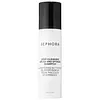What's inside
What's inside
 Key Ingredients
Key Ingredients

No key ingredients
 Benefits
Benefits

 Concerns
Concerns

 Ingredients Side-by-side
Ingredients Side-by-side

Water
Skin ConditioningCocamidopropyl Betaine
CleansingCocamide Mea
EmulsifyingPotassium Cocoyl Glycinate
PEG-7 Glyceryl Cocoate
EmulsifyingHexylene Glycol
EmulsifyingSodium Chloride
MaskingPolysorbate 20
EmulsifyingOlive Oil PEG-7 Esters
EmollientButylene Glycol
HumectantParfum
MaskingEthylhexylglycerin
Skin ConditioningCaprylhydroxamic Acid
Cetylpyridinium Chloride
AntimicrobialTropolone
Skin ConditioningCellulose
AbsorbentAlthaea Rosea Flower Extract
Skin ConditioningPerilla Frutescens Leaf Extract
MaskingPerilla Ocymoides Leaf Extract
TonicChamomilla Recutita Extract
Skin ConditioningGlycyrrhiza Glabra Root Extract
BleachingCentella Asiatica Extract
CleansingTaraxacum Officinale Leaf Extract
Skin ConditioningPanax Notoginseng Root Extract
HumectantSaponaria Officinalis Extract
Skin ConditioningBupleurum Chinense Root Extract
AstringentSalicornia Herbacea Extract
Skin ConditioningAlgae Extract
EmollientHizikia Fusiforme Extract
Skin ConditioningCodium Fragile Extract
Skin ConditioningWater, Cocamidopropyl Betaine, Cocamide Mea, Potassium Cocoyl Glycinate, PEG-7 Glyceryl Cocoate, Hexylene Glycol, Sodium Chloride, Polysorbate 20, Olive Oil PEG-7 Esters, Butylene Glycol, Parfum, Ethylhexylglycerin, Caprylhydroxamic Acid, Cetylpyridinium Chloride, Tropolone, Cellulose, Althaea Rosea Flower Extract, Perilla Frutescens Leaf Extract, Perilla Ocymoides Leaf Extract, Chamomilla Recutita Extract, Glycyrrhiza Glabra Root Extract, Centella Asiatica Extract, Taraxacum Officinale Leaf Extract, Panax Notoginseng Root Extract, Saponaria Officinalis Extract, Bupleurum Chinense Root Extract, Salicornia Herbacea Extract, Algae Extract, Hizikia Fusiforme Extract, Codium Fragile Extract
Water
Skin ConditioningSodium Lauroyl Methyl Isethionate
CleansingCocamidopropyl Betaine
CleansingDisodium Laureth Sulfosuccinate
CleansingSodium Lauryl Sulfoacetate
CleansingGlycerin
HumectantArgania Spinosa Kernel Oil
EmollientHydrolyzed Wheat Protein
Skin ConditioningHelianthus Annuus Seed Oil
EmollientPhyllostachys Nigra Leaf Extract
Skin ConditioningGlycol Distearate
EmollientHydrolyzed Vegetable Protein Pg-Propyl Silanetriol
Skin ConditioningGuar Hydroxypropyltrimonium Chloride
Skin ConditioningSodium PCA
HumectantLauryl Methyl Gluceth-10 Hydroxypropyldimonium Chloride
Amodimethicone/Morpholinomethyl Silsesquioxane Copolymer
Sodium Chloride
MaskingTrideceth-5
EmulsifyingDehydroacetic Acid
PreservativePEG-150 Pentaerythrityl Tetrastearate
EmulsifyingQuaternium-95
UV AbsorberPPG-2 Hydroxyethyl Cocamide
EmulsifyingPropanediol
SolventPentaerythrityl Tetra-Di-T-Butyl Hydroxyhydrocinnamate
AntioxidantAlpha-Isomethyl Ionone
PerfumingBenzoic Acid
MaskingLactic Acid
BufferingPotassium Sorbate
PreservativeDisodium EDTA
Phenoxyethanol
PreservativeParfum
MaskingCI 47005
Cosmetic ColorantCI 61570
Cosmetic ColorantCI 42090
Cosmetic ColorantWater, Sodium Lauroyl Methyl Isethionate, Cocamidopropyl Betaine, Disodium Laureth Sulfosuccinate, Sodium Lauryl Sulfoacetate, Glycerin, Argania Spinosa Kernel Oil, Hydrolyzed Wheat Protein, Helianthus Annuus Seed Oil, Phyllostachys Nigra Leaf Extract, Glycol Distearate, Hydrolyzed Vegetable Protein Pg-Propyl Silanetriol, Guar Hydroxypropyltrimonium Chloride, Sodium PCA, Lauryl Methyl Gluceth-10 Hydroxypropyldimonium Chloride, Amodimethicone/Morpholinomethyl Silsesquioxane Copolymer, Sodium Chloride, Trideceth-5, Dehydroacetic Acid, PEG-150 Pentaerythrityl Tetrastearate, Quaternium-95, PPG-2 Hydroxyethyl Cocamide, Propanediol, Pentaerythrityl Tetra-Di-T-Butyl Hydroxyhydrocinnamate, Alpha-Isomethyl Ionone, Benzoic Acid, Lactic Acid, Potassium Sorbate, Disodium EDTA, Phenoxyethanol, Parfum, CI 47005, CI 61570, CI 42090
 Reviews
Reviews

Alternatives
Ingredients Explained
These ingredients are found in both products.
Ingredients higher up in an ingredient list are typically present in a larger amount.
Cocamidopropyl Betaine is a fatty acid created by mixing similar compounds in coconut oil and dimethylaminopropylamine, a compound with two amino groups.
This ingredient is a surfactant and cleanser. It helps gather the dirt, pollutants, and other impurities in your skin to be washed away. It also helps thicken a product and make the texture more creamy.
Being created from coconut oil means Cocamidopropyl Betaine is hydrating for the skin.
While Cocamidopropyl Betaine was believed to be an allergen, a study from 2012 disproved this. It found two compounds in unpure Cocamidopropyl Betaine to be the irritants: aminoamide and 3-dimethylaminopropylamine. High-grade and pure Cocamidopropyl Betaine did not induce allergic reactions during this study.
Learn more about Cocamidopropyl BetaineParfum is a catch-all term for an ingredient or more that is used to give a scent to products.
Also called "fragrance", this ingredient can be a blend of hundreds of chemicals or plant oils. This means every product with "fragrance" or "parfum" in the ingredients list is a different mixture.
For instance, Habanolide is a proprietary trade name for a specific aroma chemical. When used as a fragrance ingredient in cosmetics, most aroma chemicals fall under the broad labeling category of “FRAGRANCE” or “PARFUM” according to EU and US regulations.
The term 'parfum' or 'fragrance' is not regulated in many countries. In many cases, it is up to the brand to define this term.
For instance, many brands choose to label themselves as "fragrance-free" because they are not using synthetic fragrances. However, their products may still contain ingredients such as essential oils that are considered a fragrance by INCI standards.
One example is Calendula flower extract. Calendula is an essential oil that still imparts a scent or 'fragrance'.
Depending on the blend, the ingredients in the mixture can cause allergies and sensitivities on the skin. Some ingredients that are known EU allergens include linalool and citronellol.
Parfum can also be used to mask or cover an unpleasant scent.
The bottom line is: not all fragrances/parfum/ingredients are created equally. If you are worried about fragrances, we recommend taking a closer look at an ingredient. And of course, we always recommend speaking with a professional.
Learn more about ParfumChances are, you eat sodium chloride every day. Sodium Chloride is also known as table salt.
This ingredient has many purposes in skincare: thickener, emulsifier, and exfoliator.
You'll most likely find this ingredient in cleansers where it is used to create a gel-like texture. As an emulsifier, it also prevents ingredients from separating.
There is much debate on whether this ingredient is comedogenic. The short answer - comedogenic ratings don't tell the whole story. Learn more about comegodenic ratings here.
The concensus about this ingredient causing acne seems to be divided. Research is needed to understand if this ingredient does cause acne.
Scrubs may use salt as the primary exfoliating ingredient.
Learn more about Sodium ChlorideWater. It's the most common cosmetic ingredient of all. You'll usually see it at the top of ingredient lists, meaning that it makes up the largest part of the product.
So why is it so popular? Water most often acts as a solvent - this means that it helps dissolve other ingredients into the formulation.
You'll also recognize water as that liquid we all need to stay alive. If you see this, drink a glass of water. Stay hydrated!
Learn more about Water